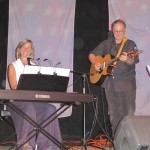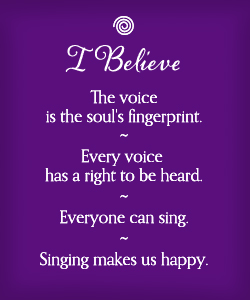Here’s a little background on how I came to “Follow the Voice.”
Every vocal problem I have ever had was a physical manifestation of an inner block, whether mental, physical, emotional or spiritual. In order to learn a new technique or vocal skill, I inevitably ran into myself – my preconceptions, my physical patterns, the connection between my breath and emotions. I discovered that singing and performing were a mirror for my inner landscape. Technique could teach me to breathe, sing and perform better, but only to a certain point. Mechanics eventually ran into the body’s energetic patterns. I realized that in order to open my voice further, I also had to look within.
I have sung all my life, with my first band in high school, church choirs, wedding solos, a college folk band, voice lessons and my first classical recital at Colby College. I loved singing, but I always wanted to be a teacher. After college, I got a Master’s in Elementary Education and had my own classroom for three years.
I met my husband, Paul, when he was in law school and a guitar player. We made a folk band, playing in local bars. I finally realized that while I loved teaching, I could always have a classroom, but I might not always be able to sing, I needed to pursue it now while I was young. I went to New England Conservatory and got a Master’s in Vocal Pedagogy. NEC was a traditional music school, stressful and hierarchical. When it came time to write my thesis, I realized that there had to be better ways of teaching and learning vocal technique. Called “Through the Back Door: a New Vocal Pedagogy,” it began my quest to affirm and help release people’s core voice.
In a conservatory, the competition is fierce. If you aren’t one of the obviously brilliant players, your judgmental, doubting voice could easily convince you of your lack of talent. I gave up singing anything classical for several years after graduating. I went back to folk music, which I loved. In my last year at NEC, I also took a master class and weekend workshop with Eloise Ristad, who wrote A Soprano on Her Head. These experiences crystallized my beliefs – that all people can sing, that singing makes people happy, and that, in its largest context, the voice is a metaphor for our lives. It is our soul print. My mantra became “Follow the voice.” It always leads me home.
When I began teaching voice lessons, I continued my exploration of alternative methods with my students. I began attracting more adult students, mostly women, who felt disconnected from their voice. Because I couldn’t find a workshop that offered what I needed at the time, I developed my own, called Vibrant Voice. My goal is always to give people an expanded experience of their voice. In the process, they breathe deeper, vibrate the whole body, tune up their entire system, and reconnect the four levels of their voice – the public voice, the private voice, the inner monologue and the core soul voice. Connecting voice to breath to heart to spirit makes people feel present and whole again.


Speak Your Mind